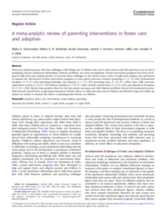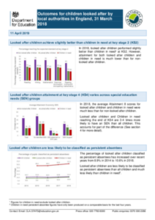Displaying 851 - 860 of 2214
This literature review examines research on the outcomes and experiences of Hispanic families in the US child welfare system and how case characteristics interact with the experiences of Hispanic families.
This study aims to explore how care is perceived and practiced among Looked after children and care leavers (LACCL) and those with a duty of care for them.
This study, part of the Bucharest Early Intervention Project, compared the consequences of long-term high-quality foster care versus standard institution-based care which began in early childhood on cardiometabolic and immune markers assessed at the time of adolescence.
The authors of this article reflect on the recently published Care Crisis Review 2018, a sector‐led review, which examines the reasons for the rise in care proceedings and the number of children in care.
In the current study, a series of eight meta-analyses were performed to examine the effectiveness of intervention programs to help foster and adoptive parents to overcome challenges on four parent outcomes, three child outcomes, and placement disruption.
The Care Pathways and Outcomes Study is a longitudinal study following 374 children who were in care and under five years old on 31/3/2000 in Northern Ireland. The study followed where the young people ended up living, whether they returned to their birth parents, went into kinship or non-relative foster care, or were adopted.
The aim of this study was to investigate the role of self-esteem as a mediator in the association between different types of child maltreatment (i.e., physical abuse, physical neglect, emotional abuse) and depressive symptomatology among a sample of adolescents in out-of-home care.
This statistical release provides national and local authority (LA) level information on the outcomes for children who have been looked after continuously for at least 12 months at 31 March 2018, by local authorities in England.
This study uses a randomised controlled trial to examine the impact of Family Group Conferencing on caseworkers’ perceptions of families’ levels of social support.
The current study comprises a secondary analysis of the 2013 Ontario Incidence Study of Reported Child Abuse and Neglect and focuses on the decision to provide ongoing child welfare services.


